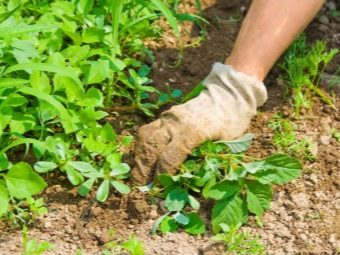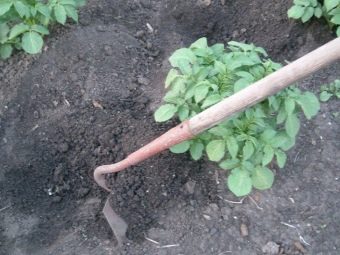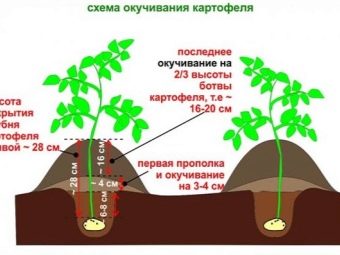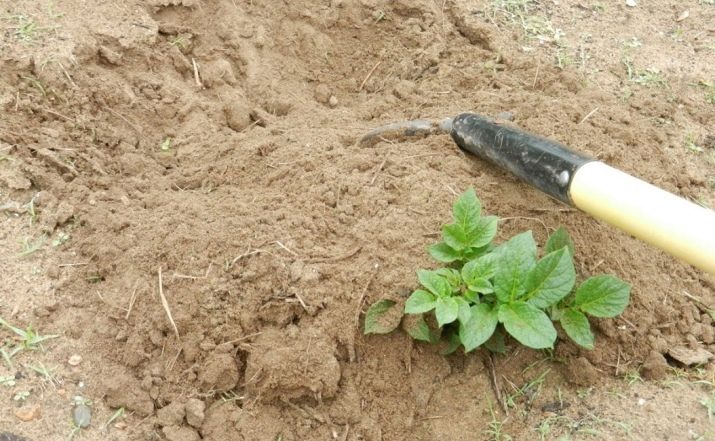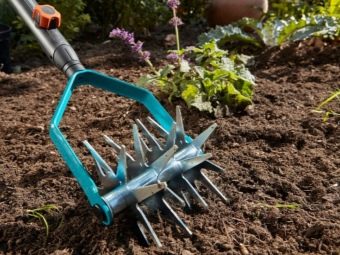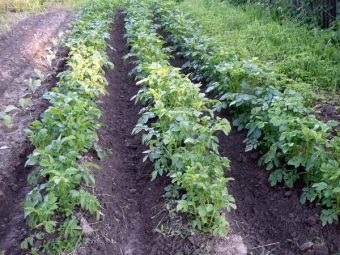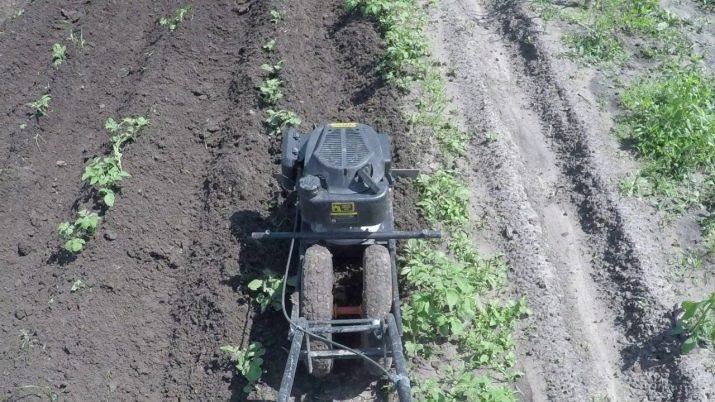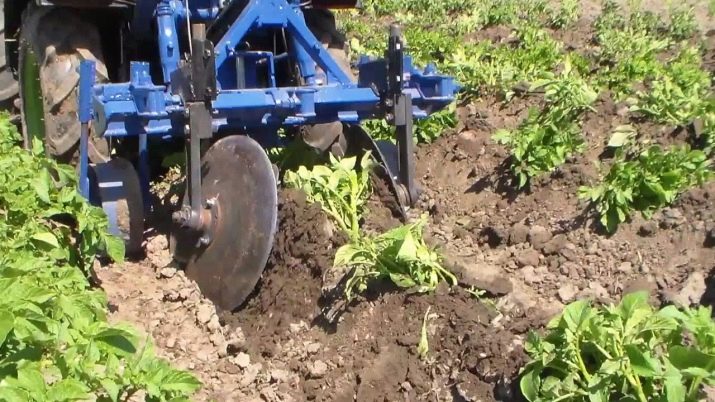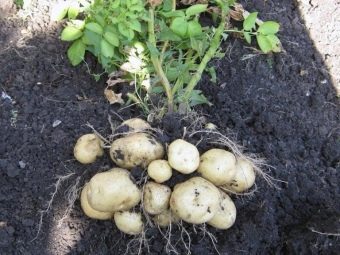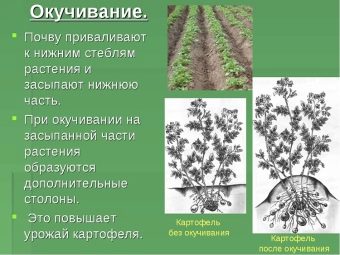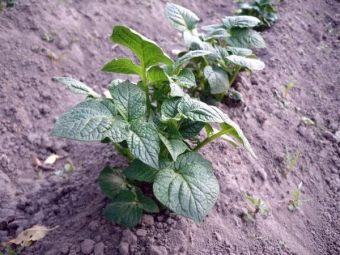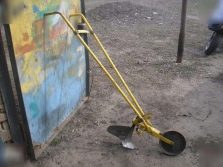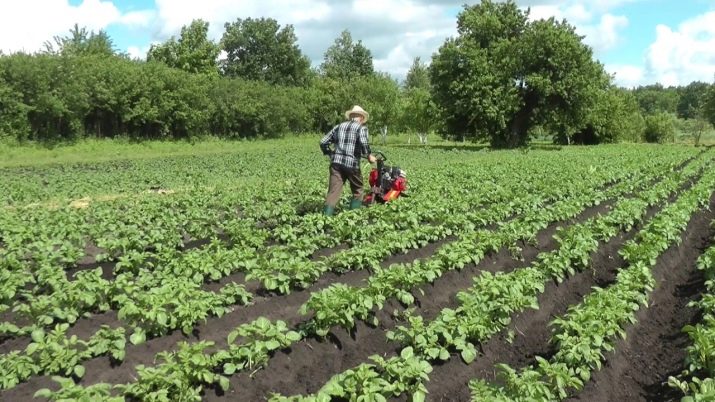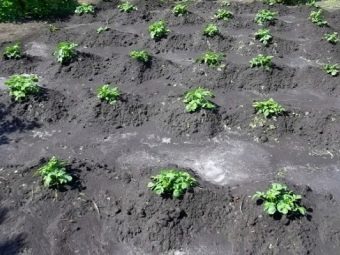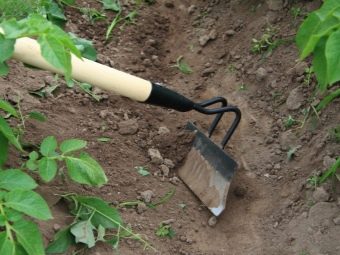Why spud potatoes, how and when to do it?
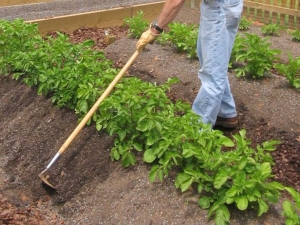
Today, any potato grower knows that hilling a crop is a particularly important stage for development and growth. However, the one who encountered this for the first time should have an idea of why it is necessary and how it is executed correctly. The topic is one of the most relevant on the gardening forums, as opinions on this subject are controversial. What is this, what is the actualization of this procedure, when necessary, how best to do it, will be discussed further.
What it is?
If you ask the city dwellers what hilling is, you can hear different versions. Sometimes it comes to the fact that under it imply digging potatoes with a shovel to eliminate weeds. In fact, this is an agricultural procedure to land on the lower parts of plants due to the soil between rows. It is not a weeding, as some gardeners mistakenly believe. In addition, weeds are removed with hoe and hands.
This is a specific type of work that is carried out after the land around the planted potato is weeded and spilled.
Outwardly, it resembles a hill of land around the stems of culture. Provided that the potatoes are planted in rows, the hill of one row will be a crest of crumbly earth. This is an environmentally friendly replacement of herbicides and a good prevention of disease.
What you need to know?
The opinion that the main reason for hilling is ridding the crop of weeds is erroneous. It should be understood that only by covering the stalks with the earth it is impossible to rid the crop of weeds that will grow with the potatoes and take all the useful substances out of the ground. In this case, it turns out that this will be care for weeds. All concepts should not be confused, because every agricultural work is different, and hilling is not a single measure for the care of a crop.
It is necessary to divide each stage of processing culture, because it goes one after another: first weeding, then loosening and pile. And for this you need to clearly represent each type of work. For example, weeding is the disposal of weeds, which is carried out manually and by means of choppers. Loosening - breaking up compressed land on both sides of the culture and between the rows.
It is often confused with hilling, as it is often performed at the same time, but the pile does not so much loose as it collects the earth. Moreover, if you lower the loosening near the shoots and between the rows, you can cover the culture with large clods of earth or layers (this is true in the case of frequent rains). Separate loosening allows you to saturate the earth with oxygen, to cover the potatoes with crumbly soil. In addition, it is the prevention of the formation of new weeds.
In general, hilling can be not only ridge (linear), but also circular (around the hole). The first method is easier to implement, while with the second one it is appropriate if there is a sufficient distance between the planted potatoes. This nuance can be a determining factor when choosing a method of agricultural work. Regarding potatoes, it is processed to form crests.
Earth when hilling can be different. More often it is wet, however, with dry summer and preliminary loosening, it can also be dry. A similar procedure can be carried out in different ways with the use of various devices. The height, speed and quality of the hilling depends on it. In addition, the complexity will be different.
An interesting nuance of hilling is the fact that it will be needed twice during the season, and for the first time you can avoid losing too much land, as they do it in the early stages of crop growth.
The reasons
Many inexperienced gardeners who plant potatoes for the first time doubt whether it is necessary to spud potatoes. In fact, the potato really needs to carry out such manipulations. Otherwise, knotted root crops will develop between the rows.In addition, in view of the trampled between the rows of the earth, they will not be able to grow properly, they can break through the soil to the outside and turn green.
If improperly developed, the size of the harvested potatoes will be small. Compressed land will also affect the shape of growing root crops: they will not be even, not all of them will grow - some will remain small, unfit for food. Hilling is necessary for potatoes as an additional amount of land in which you can grow and develop comfortably, consuming all the necessary substances from the soil. In this case, the main part of the tubers will be located in one place. Due to the adjacent land, there is a place for each root.
In addition to nascent potatoes, hilling is vital for the growth of this crop. If in the early period to sprinkle them with wet and loose soil, it will contribute to their strengthening. The stems will become more powerful, thicker, and with them the root system will develop better. The plant will be able to form correctly, due to hilling will increase its resistance to various diseases.
Due to the preliminary loosening of the soil, the roots will be provided with oxygen. It will be easier for them to get moisture without lingering at the top. Hilling is also good because in case of heavy rains the tubers will not rot, as rainwater will go down. As a rule, after the fortification, the rounded bush begins to branch, in the process of this forming under the ground more healthy root crops.
Raising the ground will delay the growth and development of weeds, which is also important when growing potatoes. At the same time, new shoots of harmful weedy plants will be much easier to pull out of the ground than from compacted soil. Land crests, among other things, can be called the protection of shoots from negative weather factors.
The fact is that the shoots covered with earth may not be afraid of light frosts, as well as of wind or small hail.
Finally, hilling not only contributes to higher yields, but also simplifies harvesting. As a rule, after digging the hole with a fork, you can often take up a bush and remove almost all the tubers from the tops. In addition, after the spud reduces the amount of damage to the potato during its digging. In other words, this work is not just recommended - it is necessary.
Better growth and development of potato bushes will affect the growth and number of leaves. This, in turn, will favorably affect photosynthesis, because it will proceed more intensively. With the development of the leaves, soluble glucose will be formed in them, which will be transferred to the culture tubers. There it will become insoluble starch.
Timing
They try to carry out the processing of potato beds after weeding and loosening. It is undesirable to do all the work at once, after weeding must pass at least a day. During this time, chopped off hopper roots of weeds will dry, so they will not be able to take root again. After the earth must be gnawed, so that it is soft and lush. This creates the best conditions for the growth and development of potatoes.
The first
It is impossible to name the exact time of the first hilling, because it depends on a number of factors. These include the landing day, the temperature in the region, the frequency of rain, sunny or overcast weather. In addition, it matters such a nuance as planting sprouted potatoes. Planting material with already available sprouts germinates, as a rule, faster.
Some gardeners cover planted potatoes with a large amount of land at once, scooping up a crest over it across the row. This is due to the protection of vegetables from possible frosts and is used in specific regions of our country. In the middle lane, such measures are resorted to less frequently. In general, spud the appeared potato sprouts for the first time should be as soon as their length reaches 5 cm.
This is a good time for early weeding, which will get rid of weeds that are gaining strength. Removing them and stinging the soil, it will turn out to saturate the forming roots with oxygen. Together with hilling, this will give a powerful impetus to development and intensive growth.
Even having covered completely ascended greens, this not only does not harm her, but also makes her stronger.
She will get out of the land dungeon the very next day. At the same time, it will not grow and develop between the rows. However, over time, the loosened soil will begin to be compressed, which is especially characteristic after heavy rains and thunderstorms. Under their influence, it will begin to sit down, and new weeds will appear.
The importance of the first hilling in the early period is explained by another factor. Not every gardener closes planted potatoes with enough land. There are cases when after a rain a root crop is seen. Early soil cover them will only benefit the potatoes.
The second
After a couple of weeks, in good weather, the potato stems with leaves will rise to 12-15 cm. This is the best time to re-hilling. Unlike the first in this case, you need to gain more land. If during this time there are weeds that grow especially intensively after the rains, you need to remove them before the pile.
It is important to have time to spud potatoes until flowering begins. If the inflorescences are already there, you will have to work very carefully. The same applies to the case when the re-hilling time is missed due to frequent rains and waiting for the soil to dry out. Usually, immediately after the first treatment, the plant is rapidly drawn out, which is noticeable every day.
If it grows, the stems may fall on the sides, and this should not be allowed in any case. It is impossible to bring the culture to such a height, because hilling in this case will be extremely inconvenient and difficult. For example, you can damage a lot of stems, trying to spud potatoes. In addition, it is worth considering that spud vegetables can and unplanned.
This will strengthen its root, support the stems, prevent them from falling and breaking. In addition, it will exclude sunlight on the growing individual tubers, which can lead to the formation of solanine poison. If re-processed, it will increase the yield of vegetable crops. And again the earth will be saturated with oxygen, and this will allow the tubers to develop better.
rules
It is impossible to call the second hilling optional. It is necessary not only in regions with clay and heavy soil. The yield of potatoes, like any culture, increases with more care. As for the third treatment, to which some gardeners have resorted, it can be noted: it is possible only in cases when the potato has not blossomed.
In this case, it should be understood that any injury to the stems is a direct way to infection (for example, late blight, Alternaria).
According to the existing rules of occlusion, it is relevant at the time. When it is lost, it will not make sense, as the tubers in search of a better land will get into the aisle. In addition, it is necessary to take into account several basic nuances that affect the yield. For example, properly spud potatoes with plenty of soil.
This is due to the fact that the thin comb will dry out very quickly. In addition, he quickly sit down, and the place for the formation of tubers will be small. When the crest is thick, there is enough space to develop more side shoots with tubers. At the same time, they will all be covered with earth.
In addition, hilling should be carried out in the morning or in the late afternoon. Ideally, it is better to choose an overcast day for this, since the soil itself will not be overheated. This will allow to cover the trunks of the shoots with moist soil, because the hot earth can cause a long rehabilitation period. We need to wait until the solar activity subsides.
Wet soil will not crumble when hilling as dry.Therefore, regardless of the choice of tool, it will turn out to cover the stems better. Such a hill will be better to keep moisture, which is important for tubers and root system.
Adaptations
All available tools for hilling can be divided into manual and mechanized.
Depending on the type of soil in a particular region, the owners acquire for such work:
- a big chopper;
- walking tractor;
- manual hiller.
Chopper
Choosing choppers as the main tool is not the best solution. This type of work is the most time consuming and takes a lot of time. Manually using this tool, you can perform the spud in two ways: separately each hole around and linearly. The first method is difficult when the planting material is located with insufficient pitch.
In this case, the shape of the hoe can be not only trapezoidal, but also triangular, and the edges rounded and sharp. Initially, a row is tucked in one direction, scooping the ground along it from beginning to end. Then move in the opposite direction, picking up the land from the row spacing approximately from the middle. The peak of the formed hill should not be sharp, since from this the earth can crumble from above.
Suitable tool for blind earthing, in which the shoots are closed completely.
Fan
There is a so-called fan type of hilling, in which the working tool is a shovel. The technique consists in picking up earth from a row and spilling it into the center of an emerging bush. Pre-shoots laid out on the ground like a fan. This method is different from the traditional method of hilling, but not every gardener agrees that it increases crop yield.
Equipment
As a working equipment, gardeners often resort to such options as a walk-behind tractor, a motor-cultivator, a plow and a disk hiller. Motoblock is a luxury, but such equipment simplifies the complexity and time of hilling. This is the most rational tool, especially in demand when potatoes are grown on a large scale. Structurally, it can be completely different, different nozzle on the trimmer, however, such devices, as a rule, need to strictly observe the distance between planted potatoes.
Disk (manual) okuchnik differs in smaller cost in comparison with the motor-block. It is much easier to work with him than with a hoe or plow. Along with hand-held devices, today you can buy a walking tractor with a disk hiller. In addition to this equipment for hilling, and suitable cultivator.
Due to the simplicity of its design, it is characterized by an acceptable cost. Such a technique can be automatic and mechanical, while along with the spud, it loosens the ground quite well. However, it is necessary to work carefully with the equipment, because if you do not keep a given course in the process, it can lead to damage to the root system of the roots. When using this unit, the user pulls it between the rows.
The plow today is mainly used by the adherents of the old traditions. If desired, the buyer can purchase a good modified model, which will allow to screw a lot of ground from the row spacing to the shoots. The plow is being pulled in order to fit the ground between the rows and to cover with it some of the trunks of the growing potato.
As a rule, this method is labor-intensive, since it is quite hard to pull the plow manually.
Tips
Finally, you can arm yourself with several tips that will help simplify the hilling process and achieve greater yields. When choosing a chopper as the main tool, you should pay attention to its size: for weeding it is smaller, while it is easier to row the ground to the holes with a couple of movements with a tool with a larger working surface. It is desirable that the edges of the instrument be sharp, since it is difficult to blunt the ground constantly with a blunt hoe and roll it to the base of the plants.
To care for the culture properly, we must not forget that from time to time she needs organic supplements. It is necessary to feed it before the growing season (before hilling). To do this, you can use different fertilizers. Some gardeners add egg shells and ashes to the wells along with the seed itself.
To spud easier, no need to wait until the ground stiffens. In addition, we should not forget that weeds grow faster than crops, and this is fraught with a decrease in some of the nutrients that vegetables consume. After the potatoes are spudded, you need to remove the weed grass from the hills that grows into the roots and hinders the development of tubers. Excessive movement of the soil will be useful, but you can not re-bare the bush to re-spud it.
When the time comes to the second hilling, you need to act delicately. At the same time, they try to take as much land as possible between the rows. Some gardeners manage to break through the areas near the base of each bush without harming the crop. Others even spud culture 3-4 times per season, considering that two times is not enough for this.
As a result, it really increases the yield, allows you to get more commodity tubers from one bush. Moreover, due to the constant addition of land filled with oxygen, they significantly increase in size and can grow everything. Inadequate care is always marked by different sizes of potatoes, in which there are several tiny pale potatoes.
It is impossible to cover the culture with land when the climate in the region is rainy. In this case, you need to "seize the moment", choosing the time until the soil is not too wet. Do not close the trunks of wet earthen slush, as it dries, it will become a shell that does not allow oxygen to go to the roots.
This will also require further loosening, and it will be problematic due to growing tubers.
Reviews
According to experienced gardeners, hilling is a vital part of potato care. It allows not only to increase the number of side shoots with tubers, but also contributes to the growth of powerful bushes. This formation of the vegetable makes it strong and resistant to short-term drought, it also protects the growing tubers from rotting. In addition, according to gardeners, it accelerates the development of potatoes, so it ripens earlier.
In general, commentators say that they perform this work twice. Those who have mechanized equipment describe the simplicity and convenience of the process itself, as well as the time saved on caring for potatoes. It is necessary to pile up longer with a chopper, and at the same time it does not work out a lot of land. In this case, the chopper itself should be tightly planted on the cutting. According to the rules, its length should reach the chin.
For more information on hilling potatoes, see the following video.



